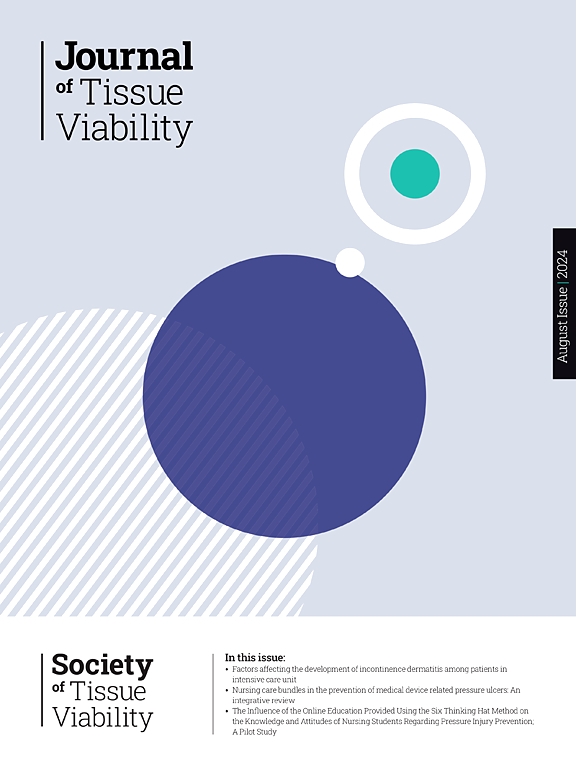Incidence rate and risk factors of intraoperative-acquired pressure injury in posterior interbody fusion: A retrospective study of a national inpatient sample database
IF 2.4
3区 医学
Q2 DERMATOLOGY
引用次数: 0
Abstract
Background
Intraoperative-acquired pressure injuries (IAPIs) are a common complication in posterior intervertebral fusion surgery, leading to adverse outcomes for patients. However, there is a lack of large-scale national database research analyzing the morbidity and associated risk factors of IAPIs in this surgical procedure.
Methods
This retrospective study analyzed data from the National Inpatient Sample (NIS) database from 2010 to 2019. Demographic, hospital, and patient characteristics were examined, including length of stay (LOS), total costs, in-hospital mortality, preoperative comorbidities, and complications.
Result
The overall incidence of IAPIs in posterior intervertebral fusion surgery was 0.2 % from 2010 to 2019. The annual occurrence of interbody fusion demonstrated an M-shaped trend, with rates of 0.2 % in 2010, 0.05 % in 2016, and 0.05 % in 2019. IAPIs were associated with increased preoperative complications, longer LOS, higher total hospitalization costs, and higher in-hospital mortality rates. Risk factors for IAPIs included comorbidities, large hospitals, urban hospitals, deficiency anemia, coagulation disorders, fluid electrolyte disorders, paralysis, and weight loss. Additionally, IAPIs were linked to medical complications such as sepsis, deep vein thrombosis, urinary tract infections, acute renal failure, shock, pneumonia, blood transfusion, and surgical complications such as cerebrospinal fluid leak. Elective admission was found to be a protective factor.
Conclusion
Identifying risk factors for IAPIs in posterior intervertebral fusion surgery can help identify high-risk patients and develop preventive measures. By targeting these risk factors, the incidence of IAPIs can be reduced, leading to improved patient outcomes.
后路椎体间融合术中获得性压力损伤的发生率和危险因素:一项对全国住院患者样本数据库的回顾性研究
背景术中获得性压力损伤(IAPIs)是后路椎间融合术的常见并发症,对患者造成不良后果。然而,缺乏大规模的国家数据库研究,分析该手术中iapi的发病率和相关危险因素。方法回顾性分析2010 - 2019年全国住院患者样本(NIS)数据库的数据。检查了人口统计学、医院和患者特征,包括住院时间(LOS)、总费用、住院死亡率、术前合并症和并发症。结果2010 - 2019年后路椎间融合术中iapi的总发生率为0.2%。体间融合的年发生率呈m型趋势,2010年为0.2%,2016年为0.05%,2019年为0.05%。iapi与术前并发症增加、LOS延长、总住院费用增加和住院死亡率升高相关。iapi的危险因素包括合并症、大型医院、城市医院、缺乏性贫血、凝血功能障碍、液体电解质紊乱、瘫痪和体重减轻。此外,iapi还与医疗并发症有关,如败血症、深静脉血栓形成、尿路感染、急性肾功能衰竭、休克、肺炎、输血和脑脊液泄漏等手术并发症。选择性录取被发现是一个保护因素。结论明确后路椎间融合术中iapi发生的危险因素,有助于识别高危患者,制定预防措施。通过针对这些危险因素,可以降低iapi的发生率,从而改善患者的预后。
本文章由计算机程序翻译,如有差异,请以英文原文为准。
求助全文
约1分钟内获得全文
求助全文
来源期刊

Journal of tissue viability
DERMATOLOGY-NURSING
CiteScore
3.80
自引率
16.00%
发文量
110
审稿时长
>12 weeks
期刊介绍:
The Journal of Tissue Viability is the official publication of the Tissue Viability Society and is a quarterly journal concerned with all aspects of the occurrence and treatment of wounds, ulcers and pressure sores including patient care, pain, nutrition, wound healing, research, prevention, mobility, social problems and management.
The Journal particularly encourages papers covering skin and skin wounds but will consider articles that discuss injury in any tissue. Articles that stress the multi-professional nature of tissue viability are especially welcome. We seek to encourage new authors as well as well-established contributors to the field - one aim of the journal is to enable all participants in tissue viability to share information with colleagues.
 求助内容:
求助内容: 应助结果提醒方式:
应助结果提醒方式:


